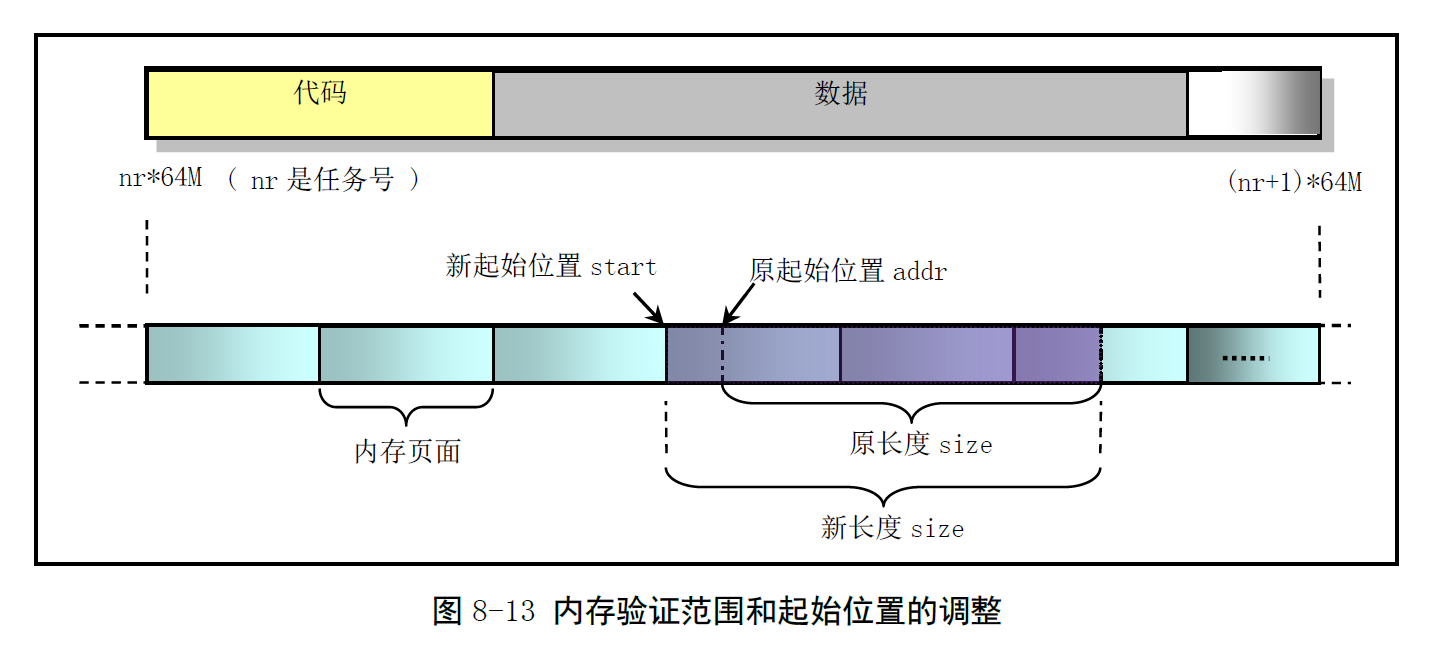Chapter 8.9 - fork.c 程序
Created by : Mr Dk.
2019 / 08 / 21 11:34
Ningbo, Zhejiang, China
8.9 fork.c 程序
8.9.1 功能描述
fork 系统调用用于创建子进程。在 Linux 中,所有进程都是进程 0 的子进程,该程序是 sys_fork() 函数的辅助处理函数集:
find_empty_process()copy_process()
copy_process() 函数用于复制进程的代码段和数据段,以及环境
- 为新建进程在主内存区中申请内存
- 复制当前进程的任务数据结构中的所有内容,作为新进程任务数据结构的模板
- 对复制的任务数据结构进行修改
- 利用系统调用发生时,压入堆栈的寄存器信息,重新设置任务结构中的 TSS
- 使新进程的状态保持父进程即将进入中断过程前的状态
- 复制当前进程的页目录项和页表项
- 同步文件使用
- 在 GDT 中设置 LDT 和 TSS,新任务设置为可运行状态,向当前进程返回新进程号
8.9.2 代码注释
进程空间区域写前验证函数 verify_area()
对于 80386 CPU,在执行特权级 0 代码时,页保护标志不起作用,copy-on-write 失去作用 - 该函数用于解决这个问题。对于 80486 CPU,内核可以通过设置 CR0 中的写保护标志 WP 禁止向用户空间只读页面写数据。检测以页为单位进行操作,因此程序需要首先定位到 addr 所在页面的基地址:

该地址是进程空间中的逻辑地址,即相对于进程起始地址空间的偏移量,然后加上进程数据段基地址,变换为 CPU 线性空间中的地址。最后调用 write_verify() 对指定大小的内存空间进行写前验证。若页面只读,则执行共享检验和写时复制:
void verify_area(void *addr, int size)
{
unsigned long start;
start = (unsigned long) addr;
size += start & 0xfff; // addr 在页内的偏移
start &= 0xfffff000; // 对齐页边界,进程空间中的逻辑地址
start += get_base(current->ldt[2]); // 加上进程数据段基址,转换为线性地址
while (size > 0) {
// 循环进行写页面验证
// 如果页面不可写,则复制页面
size -= 4096;
write_verify(start);
start += 4096;
}
}
复制内存页表函数 copy_mem()
参数 nr 是新任务号,p 是新任务数据结构的指针,为新任务在线性地址空间中设置代码段和数据段的基地址、限长,并复制页表。仅为新进程设置当前进程 (父进程) 的页目录表项和页表项,并不分配物理页面。此时,新进程与当前进程共享所有内存页面。
int copy_mem(int nr, struct task_struct * p)
{
unsigned long old_data_base, new_data_base, data_limit;
unsigned long old_code_base, new_code_base, code_limit;
code_limit = get_limit(0x0f); // 代码段选择符
data_limit = get_limit(0x17); // 数据段选择符
old_code_base = get_base(current->ldt[1]); // 代码段线性基地址
old_data_base = get_base(current->ldt[2]); // 数据段线性基地址
if (old_data_base != old_code_base)
// Linux 0.12 不支持代码段和数据段分离
panic("We don't support separate I&D");
if (data_limit < code_limit)
panic("Bad data_limit");
// 设置新进程在线性地址空间中的基地址
new_data_base = new_code_base = nr * TASK_SIZE;
p->start_code = new_code_base;
set_base(p->ldt[1], new_code_base); // 设置代码段线性基地址
set_base(p->ldt[2], new_data_base); // 设置数据段线性基地址
// 复制页表项和页目录项
if (copy_page_tables(old_data_base, new_data_base, data_limit)) {
// 复制出错,回收页表项
free_page_tables(new_data_base, data_limit);
return -ENOMEM;
}
return 0;
}
进程拷贝函数 copy_process()
复制进程信息 task[n],并设置必要的寄存器,整个地复制数据段 (也是代码段)。函数参数是汇编依次压入堆栈的寄存器数据。
int copy_process(int nr, long ebp, long edi, long esi, long gs, long none,
long ebx, long ecx, long edx, long orig_eax,
long fs, long es, long ds,
long eip, long cs, long eflags, long esp, long ss)
{
struct task_struct *p;
int i;
struct file *f;
// 为新的 PCB 申请一页
// 并将地址放入任务数组中
p = (struct task_struct *) get_free_page();
if (!p)
return -EAGAIN;
task[nr] = p;
*p = *current; // 只复制任务结构,不复制内核态堆栈
// 对复制来的任务数据结构进行一些修改
p->state = TASK_UNINTERRUPTIBLE; // 防止被内核调度执行
p->pid = last_pid; // 新进程号
p->counter = p->priority; // 进程时间片
p->signal = 0; // 信号 bitmap
p->alarm = 0; // 报警定时值
p->leader = 0; // 进程领导权不能继承
p->utime = p->stime = 0; // 用户态和核心态运行时间
p->cutime = p->cstime = 0; // 子进程用户态和核心态运行时间
p->start_time = jiffies; // 进程开始运行时间
// 修改 TSS 的内容
p->tss.back_link = 0;
p->tss.esp0 = PAGE_SIZE + (long) p; // 指向页面顶端
p->tss.ss0 = 0x10;
p->tss.eip = eip;
p->tss.eflags = eflags;
p->tss.eax = 0; // fork() 返回时,新进程返回 0
p->tss.ecx = ecx;
p->tss.edx = edx;
p->tss.ebx = ebx;
p->tss.esp = esp;
p->tss.ebp = ebp;
p->tss.esi = esi;
p->tss.edi = edi;
p->tss.es = es & 0xffff; // 段寄存器仅 16 位有效。
p->tss.cs = cs & 0xffff;
p->tss.ss = ss & 0xffff;
p->tss.ds = ds & 0xffff;
p->tss.fs = fs & 0xffff;
p->tss.gs = gs & 0xffff;
p->tss.ldt = _LDT(nr); // 任务 LDT 描述符的选择符 (LDT 描述符在 GDT 中)
p->tss.trace_bitmap = 0x80000000;
// 如果当前任务使用了协处理器,就保存上下文到新进程的 i387 中
if (last_task_used_math == current)
__asm__("clts; fnsave %0; frstor %0"::"m"(p->tss.i387));
// 复制进程页表
if (copy_mem(nr, p)) {
// 出错
task[nr] = NULL;
free_page((long) p); // 回收 PCB 所在页
return -EAGAIN;
}
// 子进程与父进程共享打开的文件
// 将对应文件的打开次数 +1
for (i = 0; i < NR_OPEN; i++)
if (f = p->filp[i])
f->f_count++;
// 父进程的 pwd、root、executable 的 inode 引用次数 +1
if (current->pwd)
current->pwd->i_count++;
if (current->root)
current->root->i_count++;
if (current->executable)
current->executable->i_count++;
if (current->library)
current->library->i_count++;
// 在 GDT 表中设置新任务的 TSS 段和 LDT 段描述符
set_tss_desc(gdt + (nr<<1) + FIRST_TSS_ENTRY, &(p->tss));
set_ldt_desc(gdt + (nr<<1) + FIRST_LDT_ENTRY, &(p->ldt));
// 将进程插入进程链表
p->p_pptr = current; // 设置新进程的父进程为当前进程
p->p_cptr = 0; // 新进程无子进程
p->p_ysptr = 0; // 新进程无更年轻的兄弟进程
p->p_osptr = current->p_cptr; // 设置新进程的老兄弟进程
if (p->p_osptr) // 设置老兄弟进程的年轻兄弟进程指针
p->p_osptr->p_ysptr = p;
current->p_cptr = p; // 设置当前进程的最新子进程
p->state = TASK_RUNNING; // 子进程就绪
return last_pid;
}
寻找进程槽 find_empty_process()
为新进程取得不重复的进程号,返回在任务数组中的 index。
int find_empty_process(void)
{
int i;
// 寻找唯一的 pid
repeat:
if ((++last_pid < 0))
last_pid = 1; // overflow
for (i = 0; i < NR_TASKS; i++)
if (task[i] && ((task[i]->pid == last_pid) || (task[i]->pgrp == last_pid)))
goto repeat;
// 唯一的 pid 已找到
// 寻找任务数组空槽
for (i = 1; i < NR_TASKS; i++)
if (!task[i])
return i; // 找到任务数组空槽
return -EAGAIN;
}